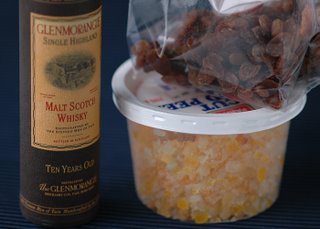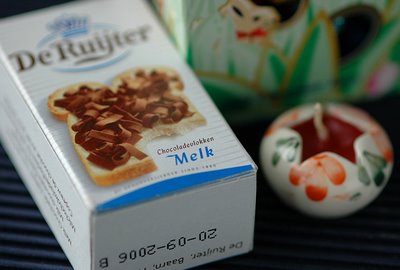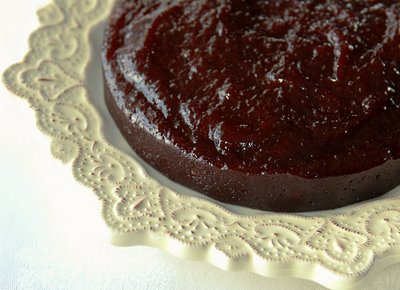
This posting is dedicated to my mum on Mother's Day - with lots of love.
Over the course of the 17th century the method used for producing quince marmalade was applied to other fruit, including oranges. The oranges available in Britain at this were bitter not sweet, so the combination of fruit and sugar was a good one. The earliest orange marmalades were therefore not dissimilar to the quince marmelada that I made in my previous posting.
Another fruit popular for preserves during the 17th century was the pippin (apples raised from a pip). Pippins are naturally high in pectin (as is the quince), so it was an easy fruit to work with. Although they too could be made into a set paste and boxed, they were generally made into a jelly of a beautiful golden translucency and presented in a glass to show off the colour. The pippin jelly was delicately flavoured and 17th century tastes preferred something stronger, and so additional fruit was added in the form of candied lemon or orange peel, or even whole fruit. The golden jelly held the fruit in suspended animation that looked pretty impressive, and so was a nifty number to serve to guests as part of your dessert course. The combination of pippin jelly with orange peel proved to be a popular one.
When Charles II's court returned from exile in France, they brought to England a small linguistic shift in fruit preserve terminology. In France preserved quinces were made into something that had a jellied consistency and that was potted not boxed. The French name for this was 'marmelade de coings'. The Restoration court (and therefore fashionable society) were thus in the habit of referring to this jellied substance as a 'marmalade', and so the name began to be applied to fruit preserves that did not necessarily match the appearance of the Portuguese marmelada. Fashions being what they are, the older forms of marmalade began to look old hat, and a new form of marmalade started to emerge.
At some point towards the end of the 17th century a cunning (but unknown) British housewife devised a method of producing a jellied preserve from bitter Seville oranges alone (no need for the addition of pippins). The first orange marmalades of this type were still much thicker than those served today, but they would have been potted, not boxed, and eaten with a spoon, not cut with a knife. The method of making the marmalade involved boiling the peel and pulp with sugar, and then pounding the softened fruit with in a mortar. Very labourious work. Eventually a second method evolved in which the peel was boiled separately to soften it, and then the peel was boiled again along with sugar, juice and pulp. The result was a opaque jelly with peel suspended in it. In Scotland the slices of peel within orange marmalade were known as
'chips' and so the preserve there often went under the name 'chip marmalade'.
There is a myth that Mary Queen of Scots introduced marmalade to Scotland, but I think this is down to the infamous pun derived from marrying her name to marmelada. Mary was seasick on the journey from France to Scotland, and is supposed to have asked for "marmelade pour Marie est malade" (quince marmalade was thought to be good for settling stomachs). It is possible that Mary help popularise French food tastes within Scotland, and that a consignment of marmelada travelled with her from France, but it was already known in Scotland before her arrival.
It was harder for Scottish housewives to obtain quinces, but there were plenty of other fruits available locally for preserve making. Oranges were imported into Scotland from the end of the 15th century. Three sugar boiling houses were established in Scotland between 1667 and 1701. Raw sugar was imported alongside the oranges, and so the two ingredients needed for orange marmalade making in Scotland were readily available by the end of the 1600s. It was this latter fact that led to Janet Keiller (often wrongly credited with inventing marmalade) to turning her hand to large-scale production of orange marmalade.

At an unknown date towards the end of the 17th century, Janet Keiller bought going cheap a load of oranges from a ship forced to dock in Dundee harbour due to bad weather. With sugar from her husband'’s grocery business she cannily turned the fruit into marmalade, which she then sold through Mr. Keiller's store. Janet, faced with a cargo load of oranges, chose to use the 'chip marmalade' method (slightly less work). Mrs. Keiller's marmalade proved to be a great success, and in Dundee in 1797 a full-time business was established producing marmalade, and also eventually producing jams, confectionery and Dundee cakes. The 'chip marmalade' would be known in England as 'Scotch marmalade', and eventually synonymously as 'Dundee marmalade' all thanks to the popularity of Keiller's product.
So this brings me neatly to a stopping off point for a quick bake. Keiller's quickly evolved into large-scale food producer, with the work-force and equipment to produce other goods alongside the marmalade. Dundee cake was first made by Keiller's at some point in the 19th century. They cannot take the credit for the recipe, as similar fruit cakes were made across Scotland, but they were able to produce cakes commercially which then sold across the globe as 'Dundee cake'. Dundee cakes are not so heavily fruited as some dried fruit based cakes, and the top of each cake is studded with blanched almonds. The use of almonds to decorate the cake in a distinctive way, was probably just a marketing ploy to ensure product individuality. For Keiller's cake making was also a clever way of ensuring the factory workers were kept busy when Seville oranges were out of season, and to use up any left-over peel.

Mary Queen of Scots pops up again in a legend connected to Dundee cake. The story goes that Mary didn'’t like cherries in her fruit cake, and so a Scottish baker came up with a special recipe which didn't include them (surely you just leave them out?). A 'genuine' Dundee cake should therefore not include cherries. I have to say though that in most of the recipes that I read they were included. Perhaps they were recipes devised by Mary's jealous cousin, Elizabeth I?
I followed the recipe sent to me by Eva (The Golden Shrimp). As part of her EBBP box to me she sent me key ingredients for Dundee cake -– mixed peel, raisin, sultanas, cherries (sorry Eva, I went with Mary on this one, but I'’ll find a good use for them in the near future), and a small bottle of whisky (a single malt! - I kept this for drinking with my cake, and used a more pedestrian whisky I already had). Eva's recipe was either for one large cake, or for several small ones. I decided to make miniature cakes. The recipe also included instructions for making a whisky syrup or saboyan to serve with the cakes, to turn them into a rather wonderful sounding dessert (recipe is from Gary Rhodes: At the Table).
175g butter
175g caster sugar
3 large egg, beaten
225g plain flour
1 tsp baking powder
1/2 tsp ground mixed spice
2 tbsp ground almonds
175g currants
175g sultanas
50g chopped glace cherries (if you want to)
50g chopped mixed peel
finely grated zest and juice of 1 lemon and 1 orange
3-4 tbsp whisky
50g blanched almonds to decorate
1. Preheat oven to 170C/325F/Gas 3. Prepare your cake tins. I used three small tins approx. 10cm across by 3 cm deep, and I also filled nine muffin cases.
2. Beat together the butter and sugar until light and creamy. Add the beaten eggs gradually.
3. Sift the flour, baking powder and spice into a bowl.
4. Put all the fruit, including the grated lemon and orange zest, into another bowl.
5. Fold the dry ingredients into the butter, sugar and egg mixture. Once well blended add the dried fruit. Finish off by adding the wet ingredients making damn sure you don’t leave out the whisky.
6. Spoon into the cake tins/cases, and place the almonds on top of the mixture in a decorative manner.
7. Gary suggests that small Dundee cakes will take about 25 minutes. I kept an eye on mine and found they took closer to 45.
8. After leaving the cakes to cool you can wrap them in greaseproof paper and store them in an airtight box. A large cake should be stored for a week before eating to improve the flavour. Me, I had a small cake (a wee morsel - see below) as soon as it was cool enough to get in my mouth. ABSOLUTELY DELICIOUS!

Incidentally, did you know that the Dalai Lama is very fond of Dundee cake?
Anyway, back to the marmalade tale. Keiller's success encouraged other Scottish grocer and kitchen supremo partnerships to launch rival businesses. James Robertson and his wife Marion set up their company in Paisley in 1864. Robertson's best known product is 'Golden Shred', still selling well today. Four years later, George and Margaret Baxter started their company in Morayshire. Alongside marmalade Baxters also made jams and other conserves. They are still a household name, and now produce all manner of foodstuffs. And so, with the success of these companies, and the initial commericalisation of the marmalade making process by Keillers, marmalade has a long association with Scotland which continues.
Much further south, the university town of Oxford was the site of an English firm which also had great sales success with its marmalade and other preserves. Frank Cooper and his wife (yet another grocer and talented cook combo) set up their business in 1874. Cooper's product was unique in the way that the marmalade was prepared, as after two boilings the softened orange pulp was left to mature for between 3 and 12 months. The finished marmalade was dark and contained coarse cut peel. The marmalade was enjoyed by students and dons, and visitors to the town took jars away with them. Business boomed. A large factory was built in Oxford right next to the railway station for ease of transportation. Cooper's success meant that Oxford is also forever associated with the sweet, sticky stuff. Chivers of Histon, Cambridgeshire and Wilkin & Sons of Tiptree, Essex, also put their towns on the marmalade map.
So, just one last thing to consider. Marmalade was first eaten at the end of the main evening meal as part of the range of dishes offered as dessert. The reason being was that oranges were considered comforting to the stomach; aides to digestion; and also stimulatory of warmth to the body. From Elizabethan times through to the 18th century, this continued to be the case. It was the medicinal benefits of oranges which led to the Scots first sampling marmalade as part of their first meal of the day - breakfast. The Scots had been in the habit of starting their day with a dram of whisky, followed by a bowl of ale with a toast floating in it. When tea drinking became fashionable in the early 18th century some people dropped the ale and took tea instead. Others swapped the whisky for a tot of body warming marmalade. The Presbytarians no doubt welcomed the loss of alcohol, but the Scottish breakfast evolved into a fine feast of a meal soon to be copied by those in the rest of Britain.

Golden Shred 'World's Best' Marmalade? To me this is reminiscent of the claim of one of our national tabloids to be 'The World's Greatest Newspaper'. I think I will leave that for you to decide...

My main source of information for both my postings on marmalade was 'The Book of Marmalade' by C. Anne Wilson. It also contains many historical recipes for marmalade, and ideas of foods to make with marmalade (cakes, trifles, pies etc.).













